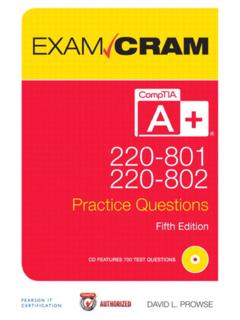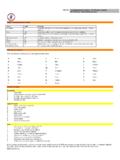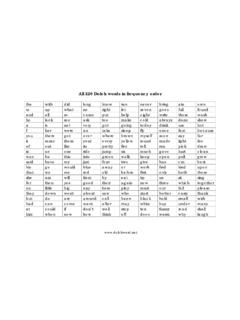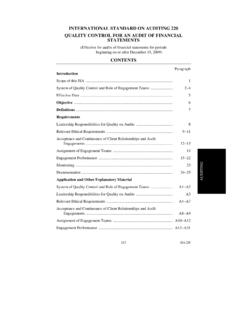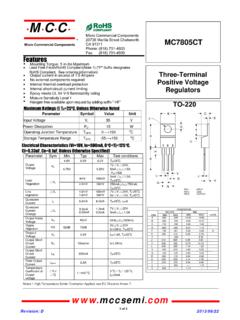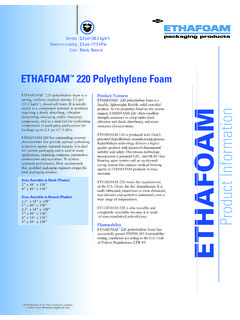Transcription of BY ORDER OF THE SECRETARY AIR FORCE …
1 BY ORDER OF THE SECRETARY OF THE AIR FORCE AIR FORCE INSTRUCTION 17-220 16 march 2017 cyberspace spectrum management COMPLIANCE WITH THIS PUBLICATION IS MANDATORY ACCESSIBILITY: Publications and forms are available on the e-Publishing website at for downloading or ordering RELEASABILITY: There are no releasability restrictions on this publication OPR: AFSMO/SQ Supersedes: AFI33-580, 24 December 2015 Certified by: SAF/A3C/A6C (Mr. Peter E. Kim, SES) Pages: 96 This instruction implements guidance and procedures for Air FORCE -wide management and use of the electromagnetic spectrum and implements Department of Defense Instruction (DoDI) , Policy and Procedures for management and Use of the Electromagnetic spectrum ; DoDI , Electromagnetic spectrum Data Sharing; National Telecommunications and Information Administration Manual of Regulations and Procedures for Federal Radio Frequency management (hereafter NTIA Manual ); Air FORCE Policy Directive (AFPD) 33-5, Warfighting Integration; and the procedures established by the Joint Staff J65A United States Military Command, Control, Communications, and Computers Executive Board (MC4EB).
2 It identifies various levels of responsibilities for Air FORCE (AF) management and use of the electromagnetic spectrum (EMS) and provides procedures for implementation. This publication applies to the Regular Air FORCE and equally to the Air FORCE Reserve (AFR), Air National Guard (ANG), and Civil Air Patrol (CAP) developing, operating, or supporting under Title 10; or General Schedule employee operating, developing, or supporting spectrum dependent (SD) equipment under Title 5; and contractors operating, developing, or supporting SD equipment in support of AF activities. The authorities to waive wing/unit level requirements in this publication are identified with a Tier ( T-0, T-1, T-2, T-3 ) number following the compliance statement. See AFI 33-360, Publications and Forms management , Table for a description of the authorities associated with the Tier numbers.
3 Submit requests for waivers through the chain of command to the appropriate Tier waiver approval authority, or alternately, to the Publication OPR for non-tiered compliance items. Refer recommended changes and technical questions about this publication to the Air FORCE spectrum management Office (AFSMO/SQ), 6910 Cooper Avenue, Fort Meade, MD 20755-7088, using AF Form 847, Recommendation for Change of Publication; route AF Forms 847 through the appropriate functional chain of command. This publication may 2 AFI17-220 16 march 2017 be supplemented at any level, but all direct Supplements must be routed to the OPR for coordination prior to certification and approval. Ensure that all records created as a result of processes prescribed in this publication are maintained in accordance with (IAW) AFMAN 33-363, management of Records, and disposed of IAW the Air FORCE Records Disposition Schedule (RDS) located at The use of the name or mark of any specific manufacturer, commercial product, commodity, or service in this publication does not imply endorsement by the AF.
4 SUMMARY OF CHANGES This document has been renumbered and substantially revised, and must be completely reviewed. Major changes include the addition of the following spectrum guidance and policy updates contained in Attachment 9, Air FORCE - DoD Area Frequency Coordinators for National and Service Test and Training Ranges and in Attachment 10, spectrum Support for Air FORCE Sponsored Exercises. 1. Overview.. 4 2. Roles and Responsibilities.. 4 Figure 1. DoD spectrum 5 3. Air FORCE spectrum management .. 7 4. spectrum Certification.. 14 5. Frequency Actions.. 18 Table 1. Joint Base Locations.. 24 6. Guidance for Specific Cases of Frequency Usage.. 25 Table 2. Standard Service Volume .. 30 Table 3. Emergency Frequencies.. 34 Table 4. FRS Frequency Pool.. 39 Table 5. FCC Part 25 Certification.. 47 7. Windmill Operations.
5 54 8. Electromagnetic spectrum Data Sharing .. 54 9. Electromagnetic spectrum Reallocation .. 55 AFI17-220 16 march 2017 3 Attachment 1 GLOSSARY OF REFERENCES AND SUPPORTING INFORMATION 57 Attachment 2 AIR FORCE spectrum CERTIFICATION 70 Attachment 3 EQUIPMENT EXEMPT FROM spectrum CERTIFICATION 76 Attachment 4 HOST NATION COORDINATION PROCESS 78 Attachment 5 spectrum SUPPORTABILITY RISK ASSESSMENT PROCESS 80 Attachment 6 FREQUENCY ASSIGNMENT CLASSIFICATION REFERENCE 86 Attachment 7 FREQUENCY ASSIGNMENT REVIEW PROCESS 90 Attachment 8 AERONAUTICAL RADIONAVIGATION spectrum MATTERS FOR FAA AND DOD AFCS 91 Attachment 9 AIR FORCE - DOD AREA FREQUENCY COORDINATORS FOR NATIONAL AND SERVICE TEST AND TRAINING RANGES 92 Attachment 10 spectrum SUPPORT OF AIR FORCE SPONSORED EXERCISES WITHIN US&P 95 4 AFI17-220 16 march 2017 1. Overview.
6 Managing the Radio Frequency (RF) spectrum . International law, domestic law, and implementing regulations require effective and efficient use of the EMS. Effective and efficient use is defined as applying design or operational techniques that conservatively use of the EMS in a compatible ( non-interference) manner. Allocation. The EMS is allocated between federal and non-federal users with portions of the spectrum shared. Federal users must utilize frequency bands allocated for government or shared use. A government frequency assignment may be authorized in a non- government band provided the request is coordinated and granted approval by the Federal Communications Commission (FCC). International spectrum management . The International Telecommunications Union (ITU) is the body responsible for international frequency allocations, worldwide telecommunications standards, and telecommunications development activities.
7 ITU Membership. The United States (US) is a member of the ITU. The legal framework of the ITU consists of the ITU Constitution and Convention, along with the administrative regulations that complement the Constitution and Convention; these documents have treaty status and are binding on ITU members. Host Nation (HN) Approval. Sovereign nations exercise control over the use of the EMS within their own territory. This basic consideration of international spectrum management becomes extremely important when US military forces operate abroad. In nearly all circumstances, it is necessary to obtain HN approval for frequency use before US forces can legally operate any SD equipment in a foreign nation. Failure to obtain HN approval has many serious consequences, including a lack of protection from interference and potential violation of international and local laws (which could lead to fines, seizures of equipment, and ultimately could potentially cause an international incident).
8 2. Roles and Responsibilities. Authority. US National spectrum management . Title 47 United States Code (USC), 151 et seq., The Communications Act of 1934, (47 USC 151) established separate control of federal (government) and non-federal (civilian) use of the EMS. The National Telecommunications and Information Administration (NTIA) Organization Act (47 USC 901, et seq.), codified the NTIA s role as the agency responsible for federal spectrum management . Non-federal spectrum use is controlled by the FCC. Under this act, the only government agencies that assign and control the use of frequencies in the US are the NTIA and the FCC. Organizations. NTIA. The NTIA assigns and regulates frequencies for all federal users within the United States and its Possessions (US&P). The NTIA governs all federal (including DoD) use of the EMS through the NTIA Manual.
9 FCC. The FCC assigns and regulates frequencies for non-federal users within the US&P. Non-federal users include private citizens, companies, and state and local government users. AFI17-220 16 march 2017 5 Department of Defense (DoD) spectrum management . The Under SECRETARY of Defense for Acquisition, Technology, and Logistics (USD [AT&L]) sets policy for acquiring systems utilizing the EMS and ensures compliance with EMS support procedures. The DoD Chief Information Officer (DoD CIO) develops overall DoD policy for managing and using the EMS. DoD activities involved in frequency management (see Figure 1.) are: US Military Command, Control, Communications, and Computers Executive Board (USMC4EB). The USMC4EB, or hereafter MC4EB , develops joint policy and provides direction in military communications-electronics (C-E) matters.
10 The MC4EB Joint Frequency Panel (JFP). The MC4EB JFP provides expert technical advice to the MC4EB in the areas of RF engineering and EMS management . Through the Equipment spectrum Guidance Permanent Working Group (ESG PWG), it reviews the characteristics of major C-E equipment purchased or developed by the DoD. This is known as the Joint Frequency Equipment Allocation Process (also called the J/F-12 Process) and is defined by requirements established by the NTIA, Interdepartmental Radio Advisory Committee (IRAC), spectrum Planning Subcommittee (SPS), and military joint or allied system review groups. The MC4EB, through the Frequency Panel s (FP) spectrum Operations Permanent Working Group (SOPWG), establishes procedures for submitting frequency assignment requests according to requirements established by the NTIA, IRAC, Frequency Assignment Subcommittee (FAS), and military joint or allied frequency assignment groups.










